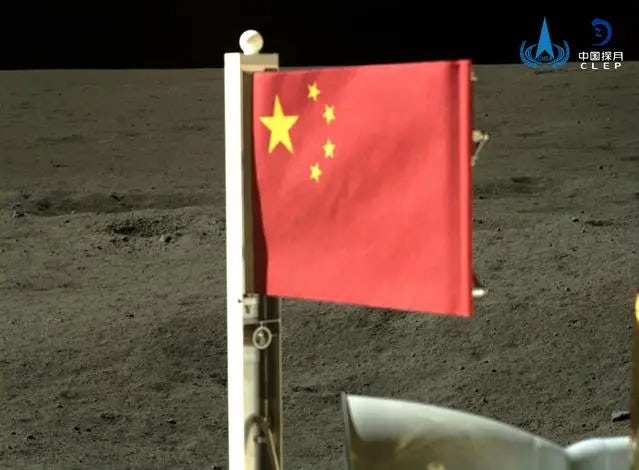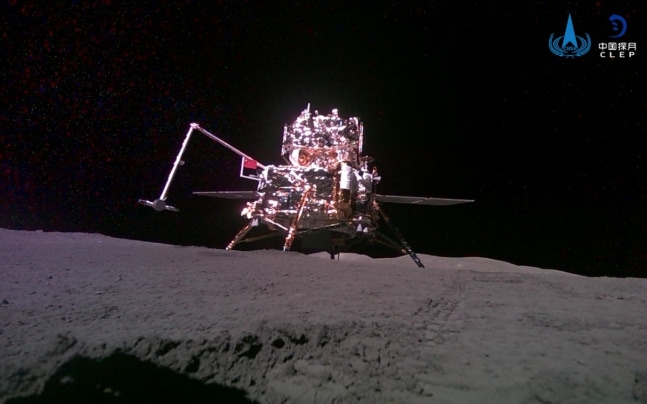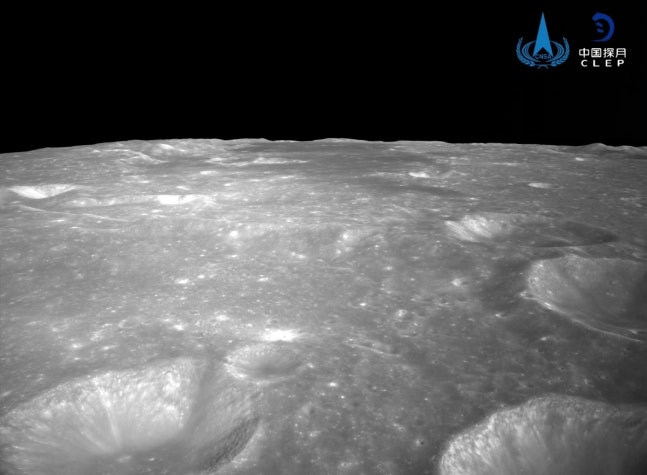[Kang Kyung-ju’s IT Cafe] Episode 140
“Sampling of ‘Antarctic-Aitken Basin’ on the Far Side of the Moon”
Made of the miraculous material Osunghonggi found on the moon
Sending Chang’e 8 to build a base in Antarctica by 2028,

Osunghonggi unfolded on the far side of the moon by Chang’e 6 / Photo=China National Space Administration,
, “China’s lunar lander ‘Chang’e 6,’ has successfully collected rock samples from the far side of the moon for the first time in the world. Landing on the far side of the moon and collecting samples is an achievement that even the United States, the world’s leading space power, has not yet accomplished, leading to predictions that competition for space dominance will intensify in the future.”,
, ‘State-owned China Central Television (CCTV) reported on the 4th that “Chang’e 6 successfully completed intelligent and speedy sampling on the far side of the moon’s ‘Antarctic-Aitken Basin’ 2-3 days ago as planned, sealing the rare sample from the far side of the moon on the ascending module.” It continued, “At 7:38 am on the 4th (China time), Chang’e 6’s ascent module carried the sample and successfully sent the module to the scheduled lunar orbit about 6 minutes after the 3000N engine operation.”‘,
,
, ‘CCTV stated, “After completing the sample collection, the Chang’e 6 lander successfully unfolded the Osunghonggi it had with it on the far side of the moon,” explaining, “This is the first time China has independently displayed its national flag on the far side of the moon, which is made of new composite materials and special processes.”‘,
,
, “Consisting of four main parts: orbiter, lander, ascent module, and re-entry module, Chang’e 6, launched on the 3rd of last month, aims to collect soil and rock samples from the far side of the moon for the first time in the world. After entering the moon’s orbit on the day of launch, it performed flights around the moon for about 30 days to prepare for landing, and landed on the targeted area, the far side of the moon’s ‘Antarctic-Aitken Basin’, on the 2nd.”,
,
,

Chang’e 6 captured by a moving camera / Photo=China National Space Administration,
, ‘CCTV claimed that in the intelligent sample collection process, a lunar probe collected samples using two methods: drilling heat on the far side of the moon and collecting samples on the surface using a mechanical arm. Furthermore, it added that the landing camera, panorama camera, lunar soil structure detector, and lunar mineral spectrum analyzer mounted on the lander operated normally, allowing the lunar surface exploration to proceed as planned.’,
,
, ‘The European Space Agency’s lunar surface ion analyzer and France’s lunar radon detector, carried on Chang’e 6, operated normally, and Italy’s laser corner reflector mounted on the lander was used for distance measurement on the far side of the moon, CCTV explained. Chang’e 6, launched with the goal of collecting approximately 2 kg of soil and rocks, is scheduled to return to Earth around the 25th of this month.’,
, ‘Attention is drawn to China’s recent achievement as its landing site is the far side of the moon. No country, including the United States, has ever landed a lander on the far side of the moon. The far side of the moon is unobservable from Earth, and direct communication requires relay satellites since radio waves do not directly reach. China landed Chang’e 4 on the far side of the moon in 2019, and through Chang’e 6, it has collected samples. China has demonstrated its national space technology capabilities to the world.’,
,
, “The United States is leading the multinational moon exploration project, ‘Artemis Program,’ with the participation of 39 countries including South Korea and Japan. The goal is to send humans to the moon by 2026 and establish a moon base by the late 2020s. In response, China is pushing forward with plans for manned lunar landings in 2030 and construction of a lunar base in the 2030s. Considering that the United States landed on the moon in the 1960s and China only began lunar exploration in 2004, China’s pace of catch-up is considered to be very rapid.”,
,
, ‘The direct reason for the power struggle between the United States and China regarding the moon is mineral resources. It is estimated that 1 million tons of helium-3, which is a raw material for nuclear fusion power generation, are buried on the moon. 1g of helium-3 produces energy equivalent to about 40 tons of coal. Other resources such as rare earth metals essential for electronics are also abundant on the moon.’,
,
,

Photo of the far side of the moon taken by Chang’e 6 / Photo=China National Space Administration,
, “China is a ‘space advanced country’ that has five universities in the top 20 of global space remote exploration and 14 in the top 100. Wuhan University, a prestigious university in Hubei Province, China, has been ranked 1st in the world university rankings for remote exploration for seven consecutive years. Also located in Wuhan, China University of Geosciences led the research on China’s first Mars probe. These two universities are also involved in lunar exploration. Building on these achievements, the Chinese Ministry of Education authorized the establishment of new planetary science departments at five universities in 2022, pouring national efforts to cultivate space talent.”,
,
, “With a rich pool of talent, China is steadily progressing its lunar exploration plans. China’s lunar exploration project, the ‘Chang’e Project,’ which began in 2003, yielded results starting in 2007. Chang’e 1 and 2 orbited the moon in 2007, creating a 3D map of the lunar surface. In 2013, Chang’e 3 became the third in the world, following the United States and Russia, to successfully land on the moon.”,
,
, ‘In 2019, Chang’e 4 became the first in the world to land on the far side of the moon. Chang’e 5, launched at the end of 2020, returned with 2 kg of rock samples collected by drilling a 1m deep hole. Chang’e 8, to be launched around 2028, will embark on experiments such as processing lunar soil on-site using 3D printing for the construction of an Antarctic base.’,
,
, ‘Jang Hairong, deputy commander at the China Manned Space Agency, previously stated at the 9th China Commercial Space Summit held in Wuhan, Hubei Province on July 12th last year, that “we will achieve manned lunar landings by 2030 to advance scientific exploration.” Wu Weiran, chief designer of China\’s lunar exploration project, said, “Despite U.S. attempts to suppress China\’s space development, our capabilities in lunar and planetary exploration have reached the world\’s highest level.”‘,
,
,

